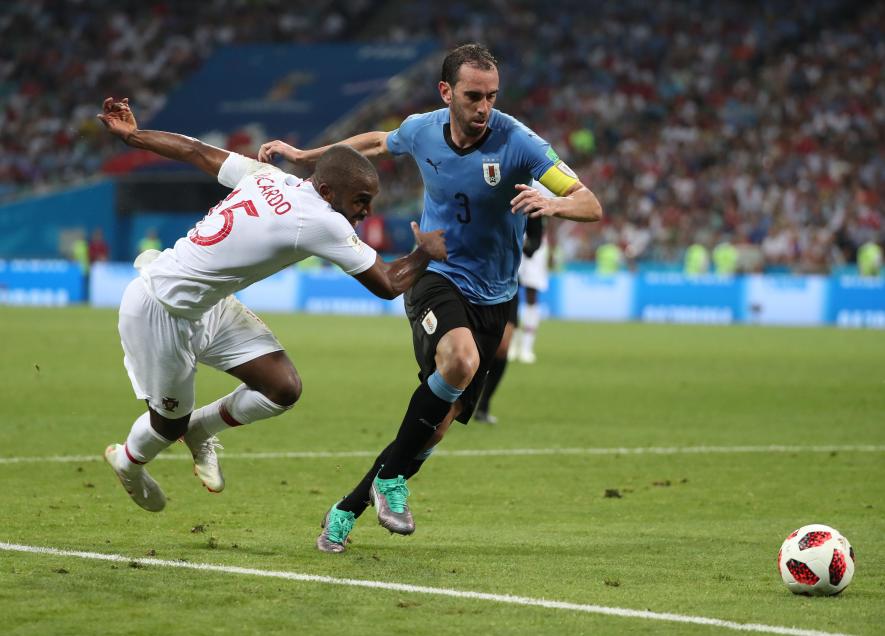FIFA World Cup: Argentina are dead. Long Live Argentina

The captain and lead man in Uruguay’s defence at FIFA World Cup is Diego Godin (right), with Jose Maria Gimenez as co-pilot -- both play for Atletico Madrid, their games forged by Argentine coach Diego Simeone's choloism (Pix: IANS).
It is quite clear now that this FIFA World Cup is not for the faint of heart. Despite some matches in the knockout rounds serving up serious snooze fests (Switzerland-Sweden and Croatia-Denmark take a bow), the undeniable fact is that this has been a tournament where not getting predictions right is perhaps the only prediction you will get right.
The key story though is how the GOATs are both home now. Portugal asphyxiated by Uruguay and Argentina outpaced by France. And Argentina’s defeat particularly rankles. Not just because one of the most delightful players in the game will sadly be denied his legacy, but also because, despite their failure, you will be hard pressed to miss the country’s influence in the success of other sides.
World Cups are tactical conventions. Teams are put together as an assortment of parts. Different clubs provide different players who play different systems but unite, when the tournament begins, to decide on which one suits them best as a nation.
READ MORE | World Cup: Lukaku, Mbappe and the Colonial Ghosts Within Belgium and France
After the success of Spain in 2010 and at Euro 2012, possession football became the bandied word. Germany’s 2014 triumph added midfield fluidity and quicker transitions to possession football. Part of the fun of watching World Cups is about seeing the club game influence the national game. Barcelona influences Spain, Dortmund influences Germany. It’s great backroom philosophy.
This World Cup has been about underdog teams sticking it to the big boys, with a heady mix of aggression, pragmatism and discipline. And here the Argentine coaching influence is tough to miss.
Argentina have historically produced some outstandingly stylish players. Look closer and you find that they have also produced some coaches who have sharply tilted the direction of the game. Marcelo Bielsa’s high pressing tactics, Jose Pekerman’s youth development, and Helenio Herrera’s catenaccio defence are but some of Argentina’s contributions to coaching science. And the trend continues, markedly because of the overarching prevalence of one coach on the character of this World Cup.
The rise of Choloism
Consider Uruguay. If they are not your outsiders bet for the trophy yet, then take a chance. The immediate reaction to watching Uruguay play in any game this World Cup (even against Saudi Arabia), is a mix of horror and joy. Horror at their miserly defence boring the game out. And joy at the way they break without touching the ball too many times. Remind you of anyone? Look no further than Diego Simeone’s Atletico Madrid.
READ MORE | In Japan’s Spirited World Cup Show, a Lesson for Other Asian Teams
Simeone, El Cholo (the aggressive), is a new age manager -- and an Argentine most famous for doing this to England of course -- who mixes Jose Mourinho’s pragmatism and discipline with Marcelo Bielsa’s model for team aggression. His teams defend hard and deep, force the opposition into spaces where attacks are rendered meaningless, and then, when they break, they do so with one clear vision, no drama: score a goal.
Unsurprisingly, the captain and lead man in Uruguay’s defence is Atletico Madrid’s Diego Godin. His co-pilot in central defence is Jose Maria Gimenez, who is -- no prizes for guessing -- also his colleague at Atletico Madrid.
Watching a team attack Uruguay is like watching newly hatched baby turtles walk from the shore to the sea. The turtles hatch on dry land and then make their way, just hatched, towards the ocean a mere 20 yards away. 20 yards of sand, policed by all manner of nature’s vile baby killers. As few as 1% of baby turtles survive to adulthood; a good proportion never complete the walk to the sea.
An opposition attacker probably feels like a baby turtle when he hurtles towards the Uruguay defence. They lie deep, and look slow, and as you move towards them, you are probably thinking "OhmygodOhmygod" only five more yards, one pass and we can score. Except that pass rarely comes along.
READ MORE | FIFA World Cup: The Life in Sudden Death
In a piece in 2013, Michael Caley argued about the merits of the through ball, and used statistics to show how shots from through balls are two to three times more likely to end up in the back of the net. A through ball, by definition, is a pass that splits the defence for a teammate to run on to. This is a through ball.
Simeone’s Atletico and Oscar Tabarez’s Uruguay (by default) implement a system in which chances off through balls just don’t happen. The team plays with a compact midfield and a dense defensive structure, which puts lots of bodies in the middle of the pitch. This forces teams to play the ball wide to their wing players. And, when they do funnel the ball back to the centre, the compact defence simply swats it away. Rinse and repeat.
In their round of 16 clash, Portugal took 20 shots at Uruguay’s goal. Five of those were on target. One ended in the back of the net (from a free header five yards out). They played zero successful through balls in ninety minutes.
Forwards and attackers aggressively join into this strategy and are constantly haranguing ball players to recover possession. And when they have the ball… well, this happens. Three precise passes. No more. No less. A nation of few, makes do with few.
Banking on English shores
And while Uruguay may be the chief proponents of this technique of Cholo football, others have sought to apply it in variations with varying degrees of success. Against Germany, Mexico pressed their ball players into areas of no-return but also alienated them from the back two.
READ MORE | Halfway through FIFA World Cup, Is VAR fighting a losing battle?
When they had the ball, they burnt the socks off Boateng and Hummels. Against Argentina, France adopted a similar tactic. They absorbed the Argentine pressure in the opening stages of the game, but closed down their creative heads effectively. At the first churn over, Kylian Mbappe took flight.
England’s spine is effectively a Tottenham Hotspur transplant. And Mauricio Pochettino’s side are one of the most effective high pressing sides in the Premier League. Kieran Trippier, Dele Alli and Harry Kane bring that ruthlessness to the national side.
The cruel irony of all this, of course, is that Jorge Sampaoli himself is a huge fan of this high-pressing brand of football -- his Chile team highlighted this in Brazil 2014. With Argentina, though, his squad failed him.
Basically what we are saying is this: Argentina may be out, but in essence, at the World Cup, an Argentina has survived. Cholo’s spirit, Pochettino’s obsession and Bielsa’s madness live on in other teams’ bodies.
Get the latest reports & analysis with people's perspective on Protests, movements & deep analytical videos, discussions of the current affairs in your Telegram app. Subscribe to NewsClick's Telegram channel & get Real-Time updates on stories, as they get published on our website.
























